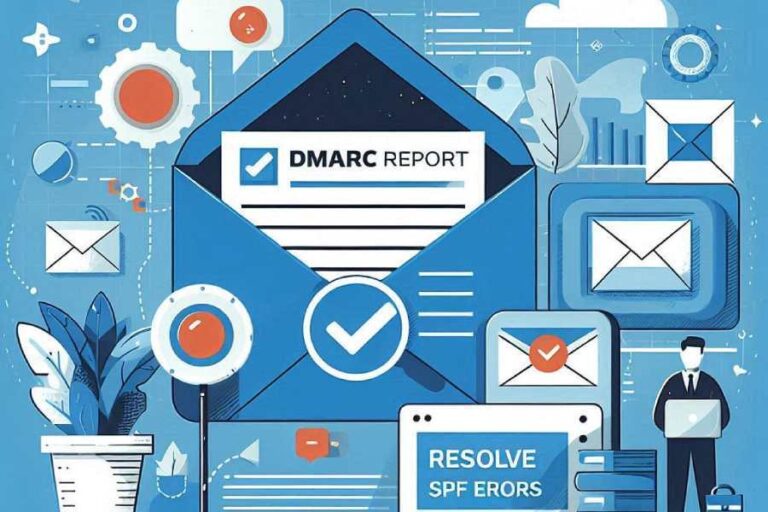GoDaddy is a popular hosting provider that offers easy-to-follow instructions on adding SPF and DKIM DNS records to stay abreast of phishing and spoofing attacks attempted to tarnish your company’s name.
These DNS records help recipients’ servers to verify the authenticity of senders to categorize emails as legitimate and illegitimate. Generally, the changes made in GoDaddy’s platform are reflected within 15 minutes. So, let’s see what steps you need to follow to set up email authentication protocols in GoDaddy.
What is SPF?
SPF is short for Sender Policy Framework, which is an email authentication protocol that relies on TXT type DNS records. An SPF record conveys information about email servers and IP addresses approved to send emails on behalf of a domain or business.
The authentication process starts when the recipient’s mail server queries the SPF record to check if the sender’s IP address is included in the list of authorized sources.
An SPF record has mechanisms like “all” (explicitly authorized servers) and “include” (allowing additional authorized servers) along with modifiers such as “soft fail” (~all) or “hard fail” (-all) to dictate the response when a non-matching server is encountered, helping tailor the level of strictness in authentication.
How to Set Up an SPF Record in GoDaddy?
Setting up an SPF record for your GoDaddy domain involves the modification of the following setting options. Here are detailed steps for the same-
Log in to Your GoDaddy Account
Open the GoDaddy website and log in to your account using credentials.
Access Domain Management
Once you have logged in, go to the ‘My Products’ section to find an option to add an SPF record.
Navigate to DNS Management
In the DNS management console, look for the domain for which you have to add an SPF record. You will spot three dots or the ‘DNS’ option to access the DNS management settings for that particular domain.
Add SPF Record
Now, look for an option to add a new record in the DNS management section.
Enter SPF Record Details
Then, enter/select the following details-
- Value field- TXT.
- Host as @.
- TXT value will be the SPF record generated manually or using an online tool.
A typical SPF record example looks like this:
v=spf1 include:example.com ~allPlease note that there shouldn’t be any white spaces or double quotes in the enclosed SPF record.
Save Changes
Click on the ‘Save’ button when the steps are completed.
Check SPF Record
It may take a while for the changes to propagate on the internet. It’s suggested to use an SPF checker to verify if an SPF record has been added in GoDaddy for your domain.
What is DKIM?
DKIM or DomainKeys Identified Mail uses cryptographic signatures added to email headers for the authentication process. A domain owner or administrator generates a unique private key and a corresponding public key, which is published in the DNS record of the sending domain.
On dispatching an email message, the sender’s mail server signs specific email headers with the private key. Using the public key retrieved from DNS, the recipient’s mail server can then verify the signature, confirming the email’s integrity and the sender’s legitimacy, helping combat email forgery and phishing.
How to Set Up a DKIM Record in GoDaddy?
The steps to set up a DKIM record in GoDaddy are similar to adding an SPF record. Let’s see what you have to follow-
Generate DKIM Keys
Use an online DKIM record generator to produce a pair of cryptographically secured public and private keys. A DKIM key is a long string of characters. It’s recommended to use DKIM keys that are 1024 bits and longer to avoid their exploitation.
Log in to your GoDaddy Account
Use credentials to log in to your account to navigate consoles and adjust settings in your favor.
Access Domain Management
Navigate to the “My Products” section on the dashboard.
DNS Management Console
Find the domain for which you have to add the DKIM record and click on the three dots or the ‘DNS’ option to adjust the DNS management settings.
Add DKIM Record
Find an option to add a new record in the DNS management section.
Add DKIM Record Details
Go to the ‘Records’ section and enter the details as follows-
- Type filed as TXT.
- Provide the public key in the ‘Host’ section.
- Add the DKIM key value in the ‘TXT Value’ section.
A typical DKIM Record looks like this-
selector._domainkey IN TXT "v=DKIM1; k=rsa; p=MIGfMA0GCSqGSIb3DQEBAQUAA4GNADCBiQKBgQD- TTL value is 3600 by default. It’s the duration for which the server should cache the information.
Save Changes
Click on the ‘Save’ button when done.
Verify Status
Once the changes are saved, it may take some time for them to propagate. To ensure that your DKIM record has been properly incorporated, you can make use of online tools specifically designed for a DKIM record check. These tools provide a comprehensive verification of your DKIM setup.
Summary
It is quite easy to add SPF and DKIM records to GoDaddy. Please ensure you run your records through an online record-checking tool or a lookup tool to avoid discrepancies and errors. For any assistance, feel free to get in touch with us at autospf.com



